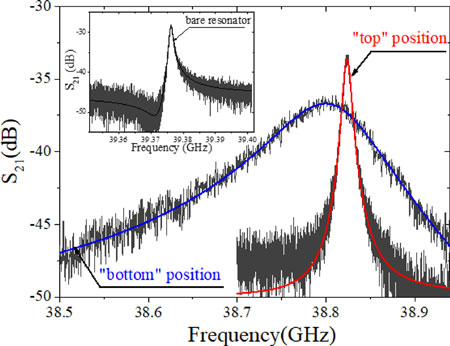| Nov 21, 2018 | |
Whispers about graphene's electrical properties |
|
| (Nanowerk Spotlight) A whispering gallery is an acoustic phenomenon that architects have used for centuries when building cathedrals. Sound waves travelling around the curved walls of a dome, such as the one in St. Paul’s Cathedral in London, allow a person standing near one part of the wall to easily hear a faint sound originating at any other part of the wall. | |
| Similarly, but much more recently, researchers have built whispering galleries for light, which are nowadays found in applications ranging from sensing, spectroscopy and communications to the generation of laser frequency combs or to boost the performance of solar cells. | |
| Yet another – but nanoscale – electronic analogue of this classical wave effect has been created in graphene to act like a circular wall of mirrors for electrons. These whispering galleries for graphene electrons open the way to building devices that focus and amplify electrons just as lenses focus light and resonators (like the body of a guitar) amplify sound. | |
| In new work, reported in Applied Physics Letters ("Contactless exploration of graphene properties using millimeter wave response of WGM resonator"), a research team from O.Usikov Institute for Radiophysics and Electronics, Kharkiv, Ukraine and Institute of Bioelectronics (ICS-8), Forschungszentrum Jülich, Germany, report the experimental results of studying the response characteristics in a millimeter wave band whispering gallery mode sapphire resonator to single-layer graphene at different distances of graphene from the resonator. | |
 |
|
| Figure 1. (a) WGM resonator, excited by dielectric waveguides: input and output, the resonator structures consisting of a sapphire disk 1 (the ellipses represent the HE141δ mode), a bare quartz substrate 2 and a graphene film 3. Here, (b) and (c) represent the schematics of just the sapphire disk and sapphire with a bare quartz substrate, respectively. (d) and (e) Depict situations where graphene is located at the bottom and at the top of the quartz substrate, respectively. (Reprinted with permission by AIP Publishing) | |
| Instead of whispering words (vibrations with a frequency range of 200-600 Hz), the scientists used this millimeter-sized whispering gallery to send out electromagnetic waves of rather large frequencies (about 40GHz) and excite the whispering gallery modes (WGM) in sapphire disks. | |
| "Interestingly, we found that the evanescent field of the resonance system is extremely sensitive to the environment, surrounding materials and disk coatings," Dr. Dmitry Kireev, one of the paper's authors, tells Nanowerk. "A series of experiments showed that such WGM resonance can be used to detect the conductivity and thickness of the materials deposited on top and/or can even be used for advanced biosensing." | |
| In order to test the level of detection, the scientists decided to explore single-layer graphene material using the WGM technique. | |
| The scientists found that the resonator system is indeed responsive to the presence of graphene. Moreover, resonance dumping is more pronounced when the graphene is in direct contact with the system and less pronounced when the graphene is slightly apart from the resonator. | |
 |
|
| Figure 2. Measured S21 coefficient dependence on the frequency for HE141δ mode. Broad and narrow resonance lines correspond to the positions “bottom” and “top” [see Figs. 1(d) and 1(e)] of graphene, respectively. The S21 transmission for the bare resonator [see Fig. 1(b)] is shown in the inset. Solid lines (blue and red) show the results of special computer processing of the measured S21 coefficient. (Reprinted with permission by AIP Publishing) | |
| "This confirms that parts of the resonance energy is absorbed by graphene," explains Kireev. "A series of experiments confirmed that the contactless WGM resonant technique allows detecting the electrical conductivity of graphene with precision comparable to a standard DC conductivity measured through steady state electrical measurements." | |
| This means that the resonator technique can be used to reveal the conductivity/sheet resistance of graphene in the millimeter wave band in a contactless and noninvasive way. | |
| Moreover, the demonstrated WGM resonator technique paves the way for contactless studies of other one-atom-thick materials in a wide range of wavelengths including sub-millimeter waves. | |
 By
Michael
Berger
– Michael is author of three books by the Royal Society of Chemistry:
Nano-Society: Pushing the Boundaries of Technology,
Nanotechnology: The Future is Tiny, and
Nanoengineering: The Skills and Tools Making Technology Invisible
Copyright ©
Nanowerk LLC
By
Michael
Berger
– Michael is author of three books by the Royal Society of Chemistry:
Nano-Society: Pushing the Boundaries of Technology,
Nanotechnology: The Future is Tiny, and
Nanoengineering: The Skills and Tools Making Technology Invisible
Copyright ©
Nanowerk LLC
|
|
|
Become a Spotlight guest author! Join our large and growing group of guest contributors. Have you just published a scientific paper or have other exciting developments to share with the nanotechnology community? Here is how to publish on nanowerk.com. |
|
